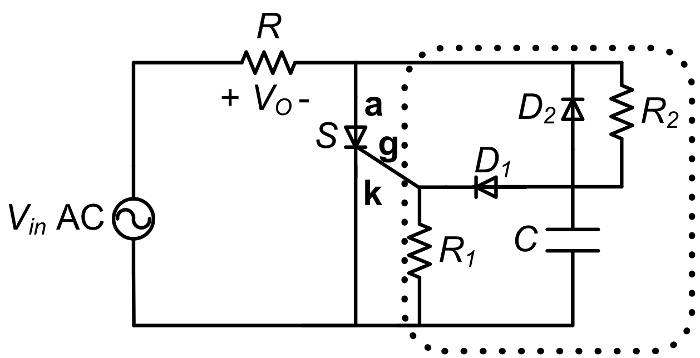Thyristor-Gleichrichter
Überblick
Quelle: Ali Bazzi, Department of Electrical Engineering, University of Connecticut, Storrs, CT.
Ähnlich wie Dioden, Thyristoren, auch genannt kontrolliert Siliziumgleichrichtern (SCRs), pass Strom in eine Richtung von der Anode zur Kathode und Stromfluss in die entgegengesetzte Richtung zu blockieren. Jedoch werden aktuelle Passage gesteuert durch ein "Tor" terminal, das erfordert einen kleinen Stromimpuls der Thyristor einschalten, so dass es Durchführung beginnen kann.
Thyristoren sind vier-Schicht-Geräte, bestehend aus abwechselnden Schichten von n-Art und p-Typ-Material, wodurch PNPN Strukturen mit drei Verbindungen bilden. Der Thyristor verfügt über drei Terminals; mit der Anode verbunden, die p-Typ-Material der PNPN-Struktur die Kathode mit der n-Schicht verbunden, und das Tor an der p-Schicht am nächsten der Kathode angeschlossen.
Das Ziel dieses Experiments ist es, eine gesteuerte Thyristor-basierte Einweggleichrichter bei unterschiedlichen Bedingungen zu studieren und verstehen, wie unterschiedliche Zeiten der Tor Puls beeinflussen die DC Ausgangsspannung.
Verfahren
Achtung: Während dieses Experiments, berühren Sie keinen Teil der Schaltung während erregt. Die VARIAC darf nicht geerdet werden.
Für dieses Experiment dient Stelltransformator (VARIAC) bei einer Low frequency von 60 Hz und Höhepunkt der 35 V als die Hauptquelle der AC.
1. setup
- Schließen Sie bevor Sie beginnen die Differenzialfühler an einem Bereich Kanal.
- Die Taste auf der Differenzialfühler zu 1/20 (20 X) Dämpfung einstellen.
Ergebnisse
Die AC-Eingangsspannung-Wellenform wird bis die Zündwinkel gehackt. Wichtige Beziehungen des durchschnittlichen Ausgang Spannung und brennen Winkel für verschiedene SCR-Gleichrichter mit Eingang Vin= V0 cos (ωt) sind:
• SCR und R Einzellast: <V,> =V0[1+cos(α)] / (2π) (2)
Anwendung und Zusammenfassung
SCR wurden häufig in älteren DC-Netzteile, die eine Variable DC Ausgangsspannung AC Eingang erforderlich. Durch den Widerstand R2 in der obigen Schaltung einstellen, es ist möglich, die durchschnittliche V,einzustellen und dafür eine einstellbare Gleichspannung liefern Ergebnisse. SCRs sind nicht häufig nicht mehr in DC-Netzteile wie wechseln sie in die Eingabezeile Frequenz (in der Regel 50 oder 60 Hz), und neue Lieferungen Netzschalter bei 10 s oder 100 s von kHz, wodurch d...
pringen zu...
Videos aus dieser Sammlung:

Now Playing
Thyristor-Gleichrichter
Electrical Engineering
17.5K Ansichten

Elektrische Sicherheitsvorkehrungen und Grundausstattung
Electrical Engineering
144.7K Ansichten

Charakterisierung von magnetischen Komponenten
Electrical Engineering
15.0K Ansichten

Einführung zu Netzteilkarten
Electrical Engineering
12.4K Ansichten

DC/DC-Aufwärtswandler
Electrical Engineering
57.0K Ansichten

DC/DC-Abwärtswandler
Electrical Engineering
21.1K Ansichten

Sperrwandler
Electrical Engineering
13.2K Ansichten

Einphasen-Transformatoren
Electrical Engineering
20.2K Ansichten

Einphasen-Gleichrichter
Electrical Engineering
23.4K Ansichten

Einphasen-Wechselrichter
Electrical Engineering
17.9K Ansichten

DC-Motoren
Electrical Engineering
23.4K Ansichten

Charakterisierung von Induktionsmotoren
Electrical Engineering
11.6K Ansichten

Umrichtergespeiste Drehstrom-Induktionsmaschinen
Electrical Engineering
6.9K Ansichten

Synchronisation von Drehstrom-Synchronmaschinen
Electrical Engineering
21.6K Ansichten

Charakterisierung von Drehstrom-Synchronmaschinen
Electrical Engineering
14.3K Ansichten
Copyright © 2025 MyJoVE Corporation. Alle Rechte vorbehalten
